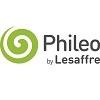
Content sponsored by:
Phileo by Lesaffre
Link between nutrition, microflora and the host
Published: January 17, 2012
By: Dr. Andrew Van Kessel (University of Saskatchewan, Canada)
It is now well recognized that the gastrointestinal tract of the pig is colonized by an abundant and taxonomically diverse microbial community. Because each of the species of organisms in the intestine possess a different "tool box" of metabolic capabilities, the relative proportion of different species of organisms changes in response to a variety of factors including age, diet composition, rearing environment and possibly genotype. Indeed, chemical composition of the diet is a major determinant of microbial composition since dietary nutrients are a major substrate for microbial fermentation. Changes in feed chemistry (ingredient selection) not only affects which species will be advantaged but also the type and abundance of fermentation products. Both compositional and species changes are likely to be important in gut health and nutrition through direct competitive exclusion of pathogens, recognition by host receptors altering gene expression, as substrates for host metabolic pathways or as toxins. Butyrate, for example has been identified as an energy source for colonocytes, an anti-inflammatory factor, and an inhibitor of virulence genes in Salmonella. In contrast, ammonia is a colonocyte toxin which might damage the epithelium increasing host susceptibility to disease.
Recently, we have focused on the interactions of fibre and low quality protein associated with by-product use in pig. High levels of non-digested protein from lower quality feed sources are available for fermentation as an energy source in the distal gut favour putrefactive bacterial species and yielding protein fermentation products including branched chained fatty acids, ammonia, amines, hydrogen sulphide and numerous other less well characterized products. Dietary fibre can displace protein fermentation as an energy source in favour of protein utilization for microbial bio-mass synthesis (microbial protein, nucleic acids etc.) reducing liberation of putative toxins. Using heat treated soybean meal as a model protein we observed increased concentrations of protein fermentation products in colon which were reduced by addition of dietary fibre (sugarbeet pulp/wheat bran). High fermentable protein diets were associated with increase in markers of colon inflammation (cell turnover, mucin, proinflammatory cytokine expression) but limited changes in epithelial permeability. Interestingly, although fibre reduced several protein fermentation products there was no amelioration of inflammatory response suggesting as yet unidentified fermentation products or other factors mediated inflammation. Whether the responses lead to disease susceptibility and whether different fibre sources or feed additives (e.g. probiotics) can negate these outcomes will be the subject of further investigation.
Recently, we have focused on the interactions of fibre and low quality protein associated with by-product use in pig. High levels of non-digested protein from lower quality feed sources are available for fermentation as an energy source in the distal gut favour putrefactive bacterial species and yielding protein fermentation products including branched chained fatty acids, ammonia, amines, hydrogen sulphide and numerous other less well characterized products. Dietary fibre can displace protein fermentation as an energy source in favour of protein utilization for microbial bio-mass synthesis (microbial protein, nucleic acids etc.) reducing liberation of putative toxins. Using heat treated soybean meal as a model protein we observed increased concentrations of protein fermentation products in colon which were reduced by addition of dietary fibre (sugarbeet pulp/wheat bran). High fermentable protein diets were associated with increase in markers of colon inflammation (cell turnover, mucin, proinflammatory cytokine expression) but limited changes in epithelial permeability. Interestingly, although fibre reduced several protein fermentation products there was no amelioration of inflammatory response suggesting as yet unidentified fermentation products or other factors mediated inflammation. Whether the responses lead to disease susceptibility and whether different fibre sources or feed additives (e.g. probiotics) can negate these outcomes will be the subject of further investigation.
Related news: Lesaffre presents symposium on pig nutrition
Related topics
Authors:
Join to be able to comment.
Once you join Engormix, you will be able to participate in all content and forums.
* Required information
Would you like to discuss another topic? Create a new post to engage with experts in the community.
Create a post18 de enero de 2012
Is the cell turnover, mucin, proinflammatory cytokine expression are markers of colon inflammation only? Why these ones can’t be markers of other unknown colon activities, in addition to inflammation?

